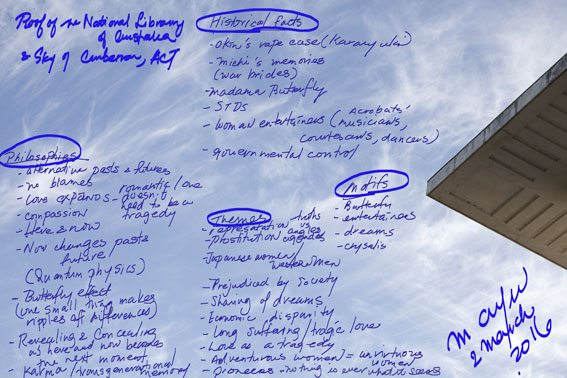Overview
I spent time researching about the diaspora of Japanese women in Australia at the National Library of Australia 8 Feb – 3 March and 21-23 March 2016 as part of the Japan Study Grant. My research focused on the karayuki san (early Japanese prostitutes) and the senso hanayome (World War II Japanese war brides). The purpose of this research was to write a new Australian play.

Details of Research Undertaken
WEEK 1: Studies focused on karayuki san in Australia, reading papers by D.C.S. Sissons in the Special Collections. His published works provided an overall understanding of the history of karayuki san, especially in relation to Australia; whilst his original manuscripts provided further information, which led to a specific karayuki san named Okin, and her rape case.
By the end of Week 1, I began to focus on Okin’s case as a starting point for the play. Further on-line research via Trove on this particular case yielded more details.

Whilst working in the Special Collections, Sisson’s writings on the early Japanese acrobats were investigated. Information in regards to groups of first known Japanese women in Australia, mostly musicians who were part of acrobatic troupes were sifted out of his research material. This aspect of my research had not been originally planned, however, this opportunity provided an interesting insight about early Japanese women in Australia, both karayuki san and musicians as being in professions, which may be described, loosely as it may seem, as in the entertainment industry.
WEEK 2: Study on karayuki san continued on Week 2 by reading books in the Asian Collections. These books were mostly written in Japanese language, and had been referenced by Sissons. These books gave me a broader understanding into the history of prostitution in Japan / Japanese prostitution abroad in historical, economic, social and philosophical contexts. Differing authors provided insights into alternative viewpoints. As a researcher for creative writing, these often opposing perspectives and varying presumptions by the authors have added many philosophical layers of meaning to the material.

WEEK 3: Studies of senso hanayome in Australia commenced in this week, reading papers by Sissons in the Special Collections, which gave an overview of Australian government’s policies, directives and decisions in regards to senso hanayome as well as newspaper reports which portrayed specific cases and general attitudes of the time. In the Asian Collections and in the General Collections, books about senso hanayome in Australia as well as in the United States provided specific senso hanayome stories, and its preceding history of post war Allied Occupation of Japan, its policies and public attitudes in regards to fraternisation and resulting marriages / children.

It was of interest and importance to my playwriting to find linkages and similarities between predicaments and public opinions in regards to senso hanayome to those of karayuki san.
WEEK 4: A detailed study of archived senso hanayome newsletters in the Asian Collection, unfettered by viewpoints of scholars, provided raw voices of senso hanayome themselves, providing invaluable insights into their lives, concerns and aspirations. The week finished with reading of a transcript from the Broome Oral History Project, which referred to a particular karayuki san as well as reading a doctorate thesis on loan through the interlibrary scheme on prostitution in parts of Western Australia, including the goldfields, where Okin’s case had taken place.
Experiences
The opportunity to spend 4 weeks concentrating on intensive research for my play was one of the highlights of my entire career. It was a kind of luxury I had never experienced before, where my entire being was able to fully input (read, take notes), digest, output (blog, conversations, diarise, mind map), dream and imagine the new work I was / am about to create.
The people working in the library were all very knowledgeable, helpful and friendly, making my daily work a joy. My special appreciation and respect goes to Mayumi Shinozaki and other librarians in the Japanese unit and all at the Overseas Collections, who made my research a daily pleasure.

It was also of value, the library’s proximity to scholars at the Australian National University, one of whom I boarded with during my 4 weeks in Canberra, and few who I met to discuss my research and play. They all imparted their respective ideas and knowledge in their area of expertise, which widened, deepened, and gave guiding posts to my creative process.
I add that the library’s environment was beautiful and sacred. I had my lunch almost everyday by the Lake Burley Griffin, musing about my work.


 Add to favorites
Add to favorites